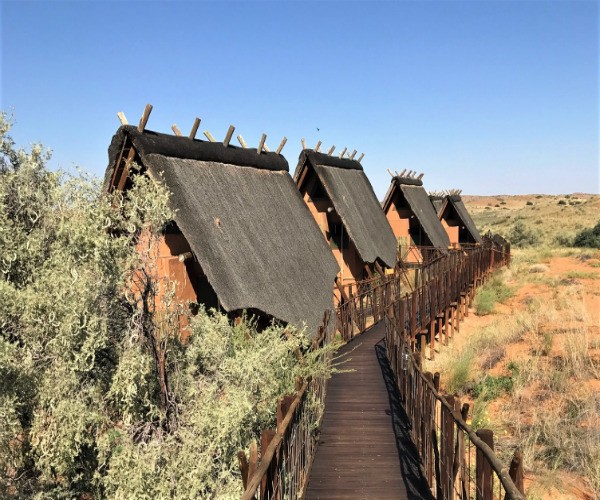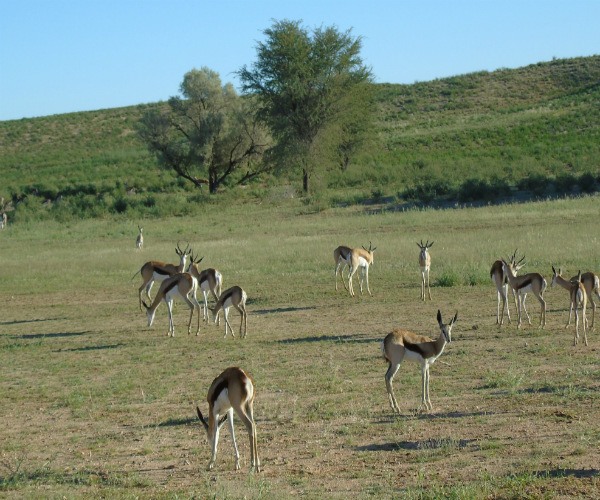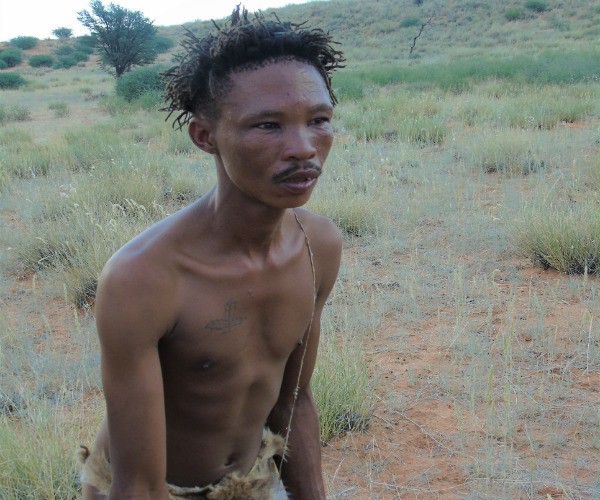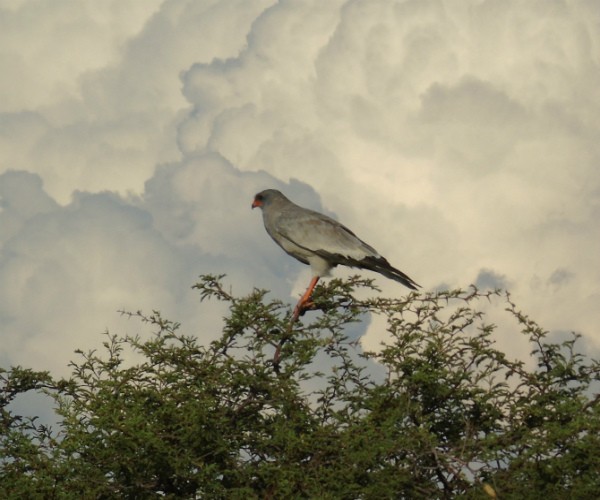Meerkats aren’t such nice guys… and 12 other Kalahari facts
First of all, the Kalahari isn’t all sand-dunes-and-camels desert. Much of the world’s biggest nature reserve, the Kgalagadi Transfrontier Park, that takes in huge chunks of South Africa and Botswana, is arid scrub, officially semi-desert. It’s a vast red-sand expanse of Lion King sunrises, bigger than Wales.
 Meerkats love burrowing in this huge dry terrain but they’re nowhere near as cute as their cuddly PR image. Professor Anne Rasa, a world authority on Mongoose and Meerkats, who runs the Kalahari’s Meerkat Sanctuary says, “Suddenly, for no apparent reason, the group attacks one meerkat, often breaking his legs and leaving him to die of starvation. After decades of research I’ve still not got any idea of what triggers an attack.”
When Meerkats bite a human they do not let go unless you pour water over them. Not always easy in a parched land which sometimes receives as little as 150mm of annual rainfall. Meerkats are ruthless with scorpions too: neatly snapping off the sting with their teeth, then downing a tasty snack.
Meerkats love burrowing in this huge dry terrain but they’re nowhere near as cute as their cuddly PR image. Professor Anne Rasa, a world authority on Mongoose and Meerkats, who runs the Kalahari’s Meerkat Sanctuary says, “Suddenly, for no apparent reason, the group attacks one meerkat, often breaking his legs and leaving him to die of starvation. After decades of research I’ve still not got any idea of what triggers an attack.”
When Meerkats bite a human they do not let go unless you pour water over them. Not always easy in a parched land which sometimes receives as little as 150mm of annual rainfall. Meerkats are ruthless with scorpions too: neatly snapping off the sting with their teeth, then downing a tasty snack.
 The Kalahari’s lions are much better behaved. Our guide John tells us on a walking safari, “In 20 years I’ve only had two incidents. Twice lionesses gave me a warning charge and stopped about seven metres short, probably because I’d intruded on their territory threatening their cubs. If they charge, don’t run. Steadily retreat backwards. If a lion charges a second-time it’s too late to read The Survival Guide.”
Lauren’s van Der Post, who wrote the classic “The Lost World of the Kalahari”, argued that lions did not like the taste of the indigenous bushman and were not man-eaters. Evidence from elsewhere on the continent suggests that as lions’ teeth age they may prefer softer human flesh.
The Kalahari’s lions are much better behaved. Our guide John tells us on a walking safari, “In 20 years I’ve only had two incidents. Twice lionesses gave me a warning charge and stopped about seven metres short, probably because I’d intruded on their territory threatening their cubs. If they charge, don’t run. Steadily retreat backwards. If a lion charges a second-time it’s too late to read The Survival Guide.”
Lauren’s van Der Post, who wrote the classic “The Lost World of the Kalahari”, argued that lions did not like the taste of the indigenous bushman and were not man-eaters. Evidence from elsewhere on the continent suggests that as lions’ teeth age they may prefer softer human flesh.
 Incredibly, 30km from the nearest tarmac road, you can stay in swimming pool-and -gourmet-dining-luxury at the heart of the Kalahari. After 70 minutes of bumping along a rough red-dust track you arrive at !Xaus Safari Lodge. Beyond wifi, with limited electricity from a generator and salt-water showers you overlook one of the Kalahari’s salt-pans; waiting for hyena, leopard and lion to drop in after nightfall.
Incredibly, 30km from the nearest tarmac road, you can stay in swimming pool-and -gourmet-dining-luxury at the heart of the Kalahari. After 70 minutes of bumping along a rough red-dust track you arrive at !Xaus Safari Lodge. Beyond wifi, with limited electricity from a generator and salt-water showers you overlook one of the Kalahari’s salt-pans; waiting for hyena, leopard and lion to drop in after nightfall.
 The Kgalagadi has two rivers but not in the conventional waster-flowing sense of the word. Don’t forget that in the local lingo Kgalagadi means “The Place of Thirst.” The rivers only “run” perhaps once or twice a century. You can only tell it is a river because it’s at the bottom of a valley with herds of springboks, oryx and wildebeest attempting to graze on some embryonic blades of grass.
The Kgalagadi has two rivers but not in the conventional waster-flowing sense of the word. Don’t forget that in the local lingo Kgalagadi means “The Place of Thirst.” The rivers only “run” perhaps once or twice a century. You can only tell it is a river because it’s at the bottom of a valley with herds of springboks, oryx and wildebeest attempting to graze on some embryonic blades of grass.
 If you are lost, and the heat is rising toward its summer peak of 45 centigrade, look for a Shepherd Tree, aka the Tree of Life. The thorny tree provided much needed shelter for shepherds as they herded their flocks of sheep or goats. Traditionally, the indigenous tribes dried, roasted and ground it’s roots to make a form of coffee, “My grandmother used to make it. Smells wonderful, tastes terrible,” our guide reminisced.
The original diminutive bushman used to spend hours following bees back to the honey-filled hives, often found in a Shepherd’s Tree, to bring sweetness to their diet. If a bushman lost his bee, he would patiently return the next day to the spot where he last saw the bee.
If you are lost, and the heat is rising toward its summer peak of 45 centigrade, look for a Shepherd Tree, aka the Tree of Life. The thorny tree provided much needed shelter for shepherds as they herded their flocks of sheep or goats. Traditionally, the indigenous tribes dried, roasted and ground it’s roots to make a form of coffee, “My grandmother used to make it. Smells wonderful, tastes terrible,” our guide reminisced.
The original diminutive bushman used to spend hours following bees back to the honey-filled hives, often found in a Shepherd’s Tree, to bring sweetness to their diet. If a bushman lost his bee, he would patiently return the next day to the spot where he last saw the bee.
 Most of the animals of the Kalahari Desert, except the giraffes, have no need of the water boreholes drilled by man. Grazing at night provides dew on the vegetation for many of the creatures. Chew the bitter Sawplant and you’ll get a refreshing blast of moisture. Lions gain all the liquid they need from the blood of their kills.
But with a dietary requirement of 15 kilos of meat a day, lions are sometimes driven to hunting a porcupine. The sight of a lion with a septic wound from a quill is frequent. Research has shown that the average lion’s stomach has a 2% porcupine content.
The Bushman used to collect bird-droppings from beneath the Social Weaver Birds’ nest and brew it up as a potent beer: it was strong stuff reserved for the tribe’s elders.
Most of the animals of the Kalahari Desert, except the giraffes, have no need of the water boreholes drilled by man. Grazing at night provides dew on the vegetation for many of the creatures. Chew the bitter Sawplant and you’ll get a refreshing blast of moisture. Lions gain all the liquid they need from the blood of their kills.
But with a dietary requirement of 15 kilos of meat a day, lions are sometimes driven to hunting a porcupine. The sight of a lion with a septic wound from a quill is frequent. Research has shown that the average lion’s stomach has a 2% porcupine content.
The Bushman used to collect bird-droppings from beneath the Social Weaver Birds’ nest and brew it up as a potent beer: it was strong stuff reserved for the tribe’s elders.
 The Weavers are compulsive nest builders. Using blades of one-year grasses they create a waterproof nest that grows larger and larger, sometimes hosting 200 or 300 birds, until it collapses from its own weight. Nests are waterproof and have a constant temperature of between 18 to 25 centigrade even when external temperatures are at the extremes of – 10 or +45.
The Weavers are compulsive nest builders. Using blades of one-year grasses they create a waterproof nest that grows larger and larger, sometimes hosting 200 or 300 birds, until it collapses from its own weight. Nests are waterproof and have a constant temperature of between 18 to 25 centigrade even when external temperatures are at the extremes of – 10 or +45.
 In a remarkable symbiotic act, the Social Weaver birds leave a chamber of the best free for the Pygmy Falcon which feeds on predators, such as snakes who try to take Weaver eggs and chicks from the nest. Look for the red excrement marking the Pygmy Falcon’s abode.
Despite the aridity and rarity of trees, the Kalahari is home to around 220 species of birds including a variety of vultures. The Secretary Bird, with what looks like three hat-pins protruding from its head, gained its name from Secretary’s hairstyles in bygone days. The Kori Bustard, sometimes weighing, in at 19 kilos is the heavyweight of the Kalahari avian world.
In a remarkable symbiotic act, the Social Weaver birds leave a chamber of the best free for the Pygmy Falcon which feeds on predators, such as snakes who try to take Weaver eggs and chicks from the nest. Look for the red excrement marking the Pygmy Falcon’s abode.
Despite the aridity and rarity of trees, the Kalahari is home to around 220 species of birds including a variety of vultures. The Secretary Bird, with what looks like three hat-pins protruding from its head, gained its name from Secretary’s hairstyles in bygone days. The Kori Bustard, sometimes weighing, in at 19 kilos is the heavyweight of the Kalahari avian world.
 If you get lost in the desert in daylight it may help that the sand-dunes run East to West. At night with light-pollution free skies you can use the formation of the stars comprising the Southern Cross for navigation. So astoundingly visible is the night sky, with comets and passing satellites visible to the naked eye, that Kgalagadi is applying for Dark Skies Reserve Status. When satellites first appeared, racing across the firmament, the Khoisan tribe who believed that you became a star after earthly life, feared that they had annoyed their ancestors.
If you get lost in the desert in daylight it may help that the sand-dunes run East to West. At night with light-pollution free skies you can use the formation of the stars comprising the Southern Cross for navigation. So astoundingly visible is the night sky, with comets and passing satellites visible to the naked eye, that Kgalagadi is applying for Dark Skies Reserve Status. When satellites first appeared, racing across the firmament, the Khoisan tribe who believed that you became a star after earthly life, feared that they had annoyed their ancestors.
 Meerkats love burrowing in this huge dry terrain but they’re nowhere near as cute as their cuddly PR image. Professor Anne Rasa, a world authority on Mongoose and Meerkats, who runs the Kalahari’s Meerkat Sanctuary says, “Suddenly, for no apparent reason, the group attacks one meerkat, often breaking his legs and leaving him to die of starvation. After decades of research I’ve still not got any idea of what triggers an attack.”
When Meerkats bite a human they do not let go unless you pour water over them. Not always easy in a parched land which sometimes receives as little as 150mm of annual rainfall. Meerkats are ruthless with scorpions too: neatly snapping off the sting with their teeth, then downing a tasty snack.
Meerkats love burrowing in this huge dry terrain but they’re nowhere near as cute as their cuddly PR image. Professor Anne Rasa, a world authority on Mongoose and Meerkats, who runs the Kalahari’s Meerkat Sanctuary says, “Suddenly, for no apparent reason, the group attacks one meerkat, often breaking his legs and leaving him to die of starvation. After decades of research I’ve still not got any idea of what triggers an attack.”
When Meerkats bite a human they do not let go unless you pour water over them. Not always easy in a parched land which sometimes receives as little as 150mm of annual rainfall. Meerkats are ruthless with scorpions too: neatly snapping off the sting with their teeth, then downing a tasty snack.
 The Kalahari’s lions are much better behaved. Our guide John tells us on a walking safari, “In 20 years I’ve only had two incidents. Twice lionesses gave me a warning charge and stopped about seven metres short, probably because I’d intruded on their territory threatening their cubs. If they charge, don’t run. Steadily retreat backwards. If a lion charges a second-time it’s too late to read The Survival Guide.”
Lauren’s van Der Post, who wrote the classic “The Lost World of the Kalahari”, argued that lions did not like the taste of the indigenous bushman and were not man-eaters. Evidence from elsewhere on the continent suggests that as lions’ teeth age they may prefer softer human flesh.
The Kalahari’s lions are much better behaved. Our guide John tells us on a walking safari, “In 20 years I’ve only had two incidents. Twice lionesses gave me a warning charge and stopped about seven metres short, probably because I’d intruded on their territory threatening their cubs. If they charge, don’t run. Steadily retreat backwards. If a lion charges a second-time it’s too late to read The Survival Guide.”
Lauren’s van Der Post, who wrote the classic “The Lost World of the Kalahari”, argued that lions did not like the taste of the indigenous bushman and were not man-eaters. Evidence from elsewhere on the continent suggests that as lions’ teeth age they may prefer softer human flesh.
 Incredibly, 30km from the nearest tarmac road, you can stay in swimming pool-and -gourmet-dining-luxury at the heart of the Kalahari. After 70 minutes of bumping along a rough red-dust track you arrive at !Xaus Safari Lodge. Beyond wifi, with limited electricity from a generator and salt-water showers you overlook one of the Kalahari’s salt-pans; waiting for hyena, leopard and lion to drop in after nightfall.
Incredibly, 30km from the nearest tarmac road, you can stay in swimming pool-and -gourmet-dining-luxury at the heart of the Kalahari. After 70 minutes of bumping along a rough red-dust track you arrive at !Xaus Safari Lodge. Beyond wifi, with limited electricity from a generator and salt-water showers you overlook one of the Kalahari’s salt-pans; waiting for hyena, leopard and lion to drop in after nightfall.
 The Kgalagadi has two rivers but not in the conventional waster-flowing sense of the word. Don’t forget that in the local lingo Kgalagadi means “The Place of Thirst.” The rivers only “run” perhaps once or twice a century. You can only tell it is a river because it’s at the bottom of a valley with herds of springboks, oryx and wildebeest attempting to graze on some embryonic blades of grass.
The Kgalagadi has two rivers but not in the conventional waster-flowing sense of the word. Don’t forget that in the local lingo Kgalagadi means “The Place of Thirst.” The rivers only “run” perhaps once or twice a century. You can only tell it is a river because it’s at the bottom of a valley with herds of springboks, oryx and wildebeest attempting to graze on some embryonic blades of grass.
 If you are lost, and the heat is rising toward its summer peak of 45 centigrade, look for a Shepherd Tree, aka the Tree of Life. The thorny tree provided much needed shelter for shepherds as they herded their flocks of sheep or goats. Traditionally, the indigenous tribes dried, roasted and ground it’s roots to make a form of coffee, “My grandmother used to make it. Smells wonderful, tastes terrible,” our guide reminisced.
The original diminutive bushman used to spend hours following bees back to the honey-filled hives, often found in a Shepherd’s Tree, to bring sweetness to their diet. If a bushman lost his bee, he would patiently return the next day to the spot where he last saw the bee.
If you are lost, and the heat is rising toward its summer peak of 45 centigrade, look for a Shepherd Tree, aka the Tree of Life. The thorny tree provided much needed shelter for shepherds as they herded their flocks of sheep or goats. Traditionally, the indigenous tribes dried, roasted and ground it’s roots to make a form of coffee, “My grandmother used to make it. Smells wonderful, tastes terrible,” our guide reminisced.
The original diminutive bushman used to spend hours following bees back to the honey-filled hives, often found in a Shepherd’s Tree, to bring sweetness to their diet. If a bushman lost his bee, he would patiently return the next day to the spot where he last saw the bee.
 Most of the animals of the Kalahari Desert, except the giraffes, have no need of the water boreholes drilled by man. Grazing at night provides dew on the vegetation for many of the creatures. Chew the bitter Sawplant and you’ll get a refreshing blast of moisture. Lions gain all the liquid they need from the blood of their kills.
But with a dietary requirement of 15 kilos of meat a day, lions are sometimes driven to hunting a porcupine. The sight of a lion with a septic wound from a quill is frequent. Research has shown that the average lion’s stomach has a 2% porcupine content.
The Bushman used to collect bird-droppings from beneath the Social Weaver Birds’ nest and brew it up as a potent beer: it was strong stuff reserved for the tribe’s elders.
Most of the animals of the Kalahari Desert, except the giraffes, have no need of the water boreholes drilled by man. Grazing at night provides dew on the vegetation for many of the creatures. Chew the bitter Sawplant and you’ll get a refreshing blast of moisture. Lions gain all the liquid they need from the blood of their kills.
But with a dietary requirement of 15 kilos of meat a day, lions are sometimes driven to hunting a porcupine. The sight of a lion with a septic wound from a quill is frequent. Research has shown that the average lion’s stomach has a 2% porcupine content.
The Bushman used to collect bird-droppings from beneath the Social Weaver Birds’ nest and brew it up as a potent beer: it was strong stuff reserved for the tribe’s elders.
 The Weavers are compulsive nest builders. Using blades of one-year grasses they create a waterproof nest that grows larger and larger, sometimes hosting 200 or 300 birds, until it collapses from its own weight. Nests are waterproof and have a constant temperature of between 18 to 25 centigrade even when external temperatures are at the extremes of – 10 or +45.
The Weavers are compulsive nest builders. Using blades of one-year grasses they create a waterproof nest that grows larger and larger, sometimes hosting 200 or 300 birds, until it collapses from its own weight. Nests are waterproof and have a constant temperature of between 18 to 25 centigrade even when external temperatures are at the extremes of – 10 or +45.
 In a remarkable symbiotic act, the Social Weaver birds leave a chamber of the best free for the Pygmy Falcon which feeds on predators, such as snakes who try to take Weaver eggs and chicks from the nest. Look for the red excrement marking the Pygmy Falcon’s abode.
Despite the aridity and rarity of trees, the Kalahari is home to around 220 species of birds including a variety of vultures. The Secretary Bird, with what looks like three hat-pins protruding from its head, gained its name from Secretary’s hairstyles in bygone days. The Kori Bustard, sometimes weighing, in at 19 kilos is the heavyweight of the Kalahari avian world.
In a remarkable symbiotic act, the Social Weaver birds leave a chamber of the best free for the Pygmy Falcon which feeds on predators, such as snakes who try to take Weaver eggs and chicks from the nest. Look for the red excrement marking the Pygmy Falcon’s abode.
Despite the aridity and rarity of trees, the Kalahari is home to around 220 species of birds including a variety of vultures. The Secretary Bird, with what looks like three hat-pins protruding from its head, gained its name from Secretary’s hairstyles in bygone days. The Kori Bustard, sometimes weighing, in at 19 kilos is the heavyweight of the Kalahari avian world.
 If you get lost in the desert in daylight it may help that the sand-dunes run East to West. At night with light-pollution free skies you can use the formation of the stars comprising the Southern Cross for navigation. So astoundingly visible is the night sky, with comets and passing satellites visible to the naked eye, that Kgalagadi is applying for Dark Skies Reserve Status. When satellites first appeared, racing across the firmament, the Khoisan tribe who believed that you became a star after earthly life, feared that they had annoyed their ancestors.
If you get lost in the desert in daylight it may help that the sand-dunes run East to West. At night with light-pollution free skies you can use the formation of the stars comprising the Southern Cross for navigation. So astoundingly visible is the night sky, with comets and passing satellites visible to the naked eye, that Kgalagadi is applying for Dark Skies Reserve Status. When satellites first appeared, racing across the firmament, the Khoisan tribe who believed that you became a star after earthly life, feared that they had annoyed their ancestors.
Did you enjoy this article?
Receive similar content direct to your inbox.


